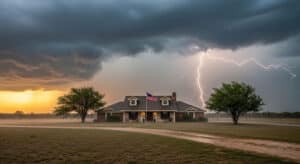1) 24/7 Availability & Real Response Windows
First, speed matters—but clarity matters more. Ask how the company defines “rapid response.” Do they pick up live at 2 a.m., text you an ETA, and dispatch triage within hours? A credible provider of Houston Emergency Roof Replacement (24/7 Rapid Response) should share a simple playbook: intake → photo/video triage → temporary dry-in → full replacement. Additionally, confirm they serve your ZIP, can scale during city-wide storms, and disclose any after-hours fees up front. In short, speed is step one; process is what prevents chaos later.
What to look for: 24/7 phone coverage, written ETAs, escalation tiers, service radius, transparent fees.
2) Emergency Tarping & Dry-In Capabilities
Next, stop the water—fast. The right emergency roofing contractor arrives with tarps, synthetic underlayment, cap nails, and ice/water barrier ready to go. They should also explain where tarps tie off, how penetrations are sealed, and how chimneys/skylights are handled during the interim. Plus, request moisture readings and basic interior protection (plastic containment, floor runners). This way, ceilings, framing, and electrical stay dry while your permanent replacement is planned.
What to look for: stocked emergency kits, night-work protocol, moisture mapping, interior protection.
3) Licensing, Insurance & Compliance in Texas
Also, protect yourself on paper. Ask for current general liability and workers’ comp certificates (with you listed as certificate holder). For Houston Emergency Roof Replacement (24/7 Rapid Response), the contractor must know local permitting, wind ratings, and HOA/ARC rules. Then, confirm lien releases, a W-9, and a physical business address. So, if anything goes wrong—injury or property damage—you’re covered.
What to look for: COI with your name, permit plan, lien release process, legal entity on the contract. Visit the Houston Permitting Center to confirm roofing permit requirements and local code compliance.
4) Storm & Hail Expertise Specific to Houston
Because Houston weathers hail, wind, and tropical systems, you need storm fluency. The best teams use chalk tests, attic checks, and photo grids to separate cosmetic from functional damage. A seasoned urgent roof replacement partner understands adjuster guidelines, recommends climate-appropriate underlayments/fastening, and stages work when supply chains are tight. Finally, ask how they handle mid-project storms—do they have a re-tarp protocol and rapid re-mobilization plan?
What to look for: hail diagnosis methods, wind-uplift fastening plans, storm logistics playbook.
5) Transparent Inspections (Photo/Video Evidence)
Then, insist on proof. Expect high-res photos, short video clips, attic images, and moisture logs. A trustworthy Houston Emergency Roof Replacement (24/7 Rapid Response) report labels slopes, flashing, penetrations, and decking conditions. Moreover, ask for a shareable PDF/link with timestamps and a short summary separating “fix now” from “monitor.” This keeps scope creep in check and smooths insurance conversations.
What to look for: annotated photos, moisture logs, attic images, labeled diagrams.
6) Written Scope, Pricing & Change-Order Policy
Now lock in the details. A strong emergency roof replacement estimate breaks down tear-off, decking allowances, underlayment, flashing, ventilation, and cleanup. It should also show unit pricing (e.g., per sheet of decking), permit/tax line items, and any after-hours surcharges. Importantly, change-orders should require photos and signatures before extra work begins. Clear terms keep projects moving—and costs predictable.
What to look for: line-item estimate, unit costs, exclusions, documented change-orders.
7) Insurance Claims Assistance
After storms, paperwork can overwhelm. Look for a contractor who provides claim-friendly inspection reports, attends adjuster meetings, and prepares Xactimate-style estimates. A Houston Emergency Roof Replacement partner should explain ACV vs. RCV, depreciation, deductibles, and how final invoices trigger carrier releases. With the right documentation, your claim moves faster—and with fewer surprises.
What to look for: adjuster coordination, supplement process, clear photo/video evidence.
8) Crew Size, Supervision & Safety Protocols
Safety comes next. A dependable Houston Emergency Roof Replacement (24/7 Rapid Response) provider assigns an on-site supervisor, runs toolbox talks, and documents fall-protection checks. Crew size should match roof complexity so work finishes quickly without shortcuts. Additionally, ask who can approve changes, whether subs are background-checked, and how night lighting is handled. Safe jobs are efficient jobs.
What to look for: named project manager, safety plan, PPE list, daily checklists.
9) Ventilation & Waterproofing Upgrades
While you’re at it, fix underlying issues. Consider synthetic underlayment, extended ice/water shield in valleys/eaves, and balanced intake/exhaust ventilation. Effective emergency roofing service includes NFA (net free area) calculations and clear ridge/box vent recommendations. As a result, shingles last longer, framing stays drier, and warranties remain valid.
What to look for: NFA calculations, underlayment specs, ridge/soffit recommendations.
10) Warranty Coverage You Can Actually Use
Finally, make sure coverage is real. Clarify material vs. workmanship terms, transferability, wind/hail limits, and exclusions tied to ventilation or installation. The right Houston Emergency Roof Replacement (24/7 Rapid Response) team registers your material warranty and issues a workmanship certificate at closeout. Moreover, ask for sample documents and proof of any manufacturer certifications.
What to look for: written workmanship warranty, manufacturer registration, sample docs.



